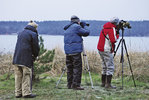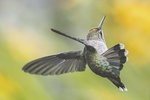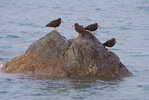About the same number of species as usual were spotted by Admiralty Audubon Chapter members who were out with binoculars and notepads Dec. 17 doing their part for the annual national Christmas Bird …
This item is available in full to subscribers.
We have recently launched a new and improved website. To continue reading, you will need to either log into your subscriber account, or purchase a new subscription.
If you had an active account on our previous website, then you have an account here. Simply reset your password to regain access to your account.
If you did not have an account on our previous website, but are a current print subscriber, click here to set up your website account.
Otherwise, click here to view your options for subscribing.
* Having trouble? Call our circulation department at 360-385-2900, or email our support.
Please log in to continue |
|



About the same number of species as usual were spotted by Admiralty Audubon Chapter members who were out with binoculars and notepads Dec. 17 doing their part for the annual national Christmas Bird Count.
This year, there were more participants than ever before.
“The number of participants is above 50 for the first time,” said Dan Waggoner, one of the Christmas Bird Count coordinators for the event. “The biggest misses were sharp-shinned and Cooper’s hawks. The freshwater waterfowl numbers definitely are down.
“The highlight was the three Bohemian waxwings that Ken Wilson and his group found on Olele Point Road north of Mats Mats Bay. Also, the group found four different species of owls: great horned, northern saw-whet, barred and barn,” he said.
“It was a tough, snowy, very cold day for us. We had many misses on usual daily birds that should have been seen,” said Paula Vanderheul, one of the Dec. 17 trip leaders.
While cold weather had been hovering over East Jefferson County for a week, the snowfall on the morning of Dec. 17 was a surprise.
The cold and blowing snow led ducks, for example, to crowd into small circles of open water surrounded by ice in ponds and lagoons that had been nearly free of ice a day earlier.
“It’s difficult to sort individual numbers and species when the ducks you’re trying to count are a multiheaded, multispecies conglomerate of animated feathers trying to stay warm,” said Admiralty Audubon volunteer Debbie Jahnke. “And your breath keeps fogging up your binoculars.
Preliminary numbers from the East Jefferson circle count list 117 species, although not all in the field or feeder counts have been registered yet, and some rare species have been noted that will be added to the list.
“The raptors had sense enough to stay under cover on Saturday, absent a few bald eagles and red-tailed hawks,” Jahnke noted. Not observed were the usual harriers, sharp-shinned hawks, Cooper’s hawks, merlins, kestrels and peregrines.
117th YEAR
This year marked the 117th anniversary of the Christmas Bird Count (CBC), which is the longest continuously running biological census in the world, Jahnke noted. The count demonstrates the power of “citizen science.” as the data provide researchers with information about how our continent’s birds have changed in time and space, she noted.
CBC regions are divided into 15-mile-diameter count circles and then further divided among logical counting routes and feeder counting. Admiralty Audubon’s East Jefferson County circle is centered near the pier at Naval Magazine Indian Island. The count takes place east of Marrowstone Island to Discovery Bay, south past Anderson Lake, and north to Point Wilson. Many people also count at their own bird feeders.
Once a counting circle picks its count day, anywhere from Dec. 14 to Jan. 5, that’s when the count is conducted, bad weather or not. There’s also the consolation prize of “count week,” three days before and three days after the selected count day, when species not observed on the specific day may be included in note form, just not on the official count list.
For example, on Dec. 17, one group walked Kah Tai Lagoon Nature Park, while others started at Point Hudson and walked the shoreline toward Fort Worden State Park, and another group started at Point Hudson and walked toward the paper mill and Fort Townsend State Park.
Along with a Dec. 17 bird count in Port Townsend, Admiralty Audubon members participated in counts on Dec. 18 at Neah Bay and on Dec. 19 in Sequim.
HUMMINGBIRDS
One type of bird that is more common now than 20 years ago, Admiralty Audubon’s CBC coordinator and Quilcene resident Dan Waggoner said, are Anna’s hummingbirds.
“They’ve gone from one or two on our count up to 40 or 50,” Waggoner said of the hummingbird. “They winter over because people are feeding them, and people are planting plants that still have flowers.”
Hummingbirds stay near sea level this time of year because generally it’s not as cold at lower elevations.
Recent counts indicate plenty of gulls and puffins, but fewer seabirds, Waggoner noted.
No snowy owls have been spotted in East Jefferson County this season.